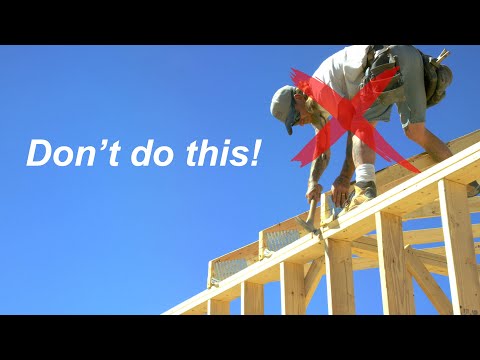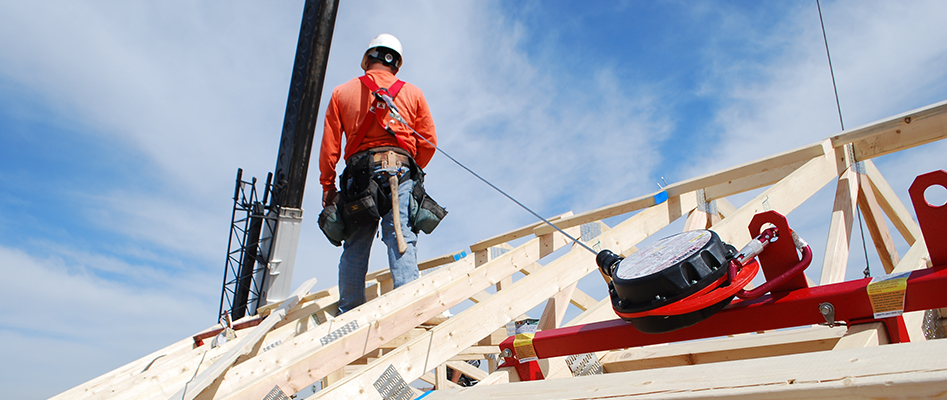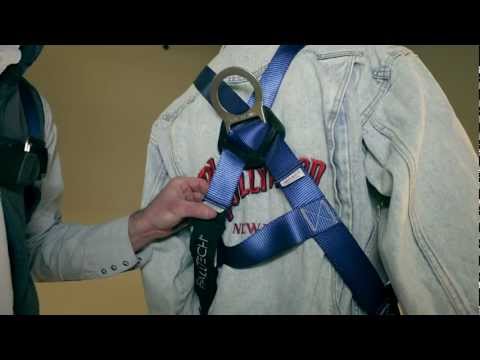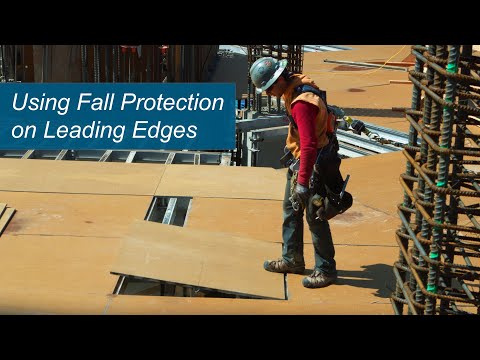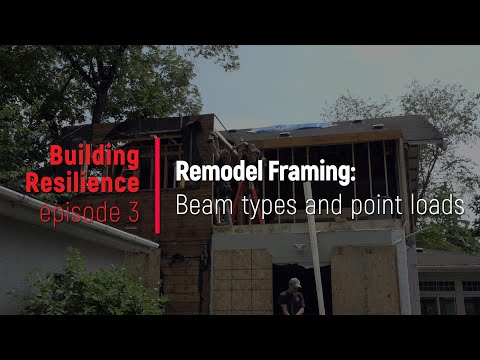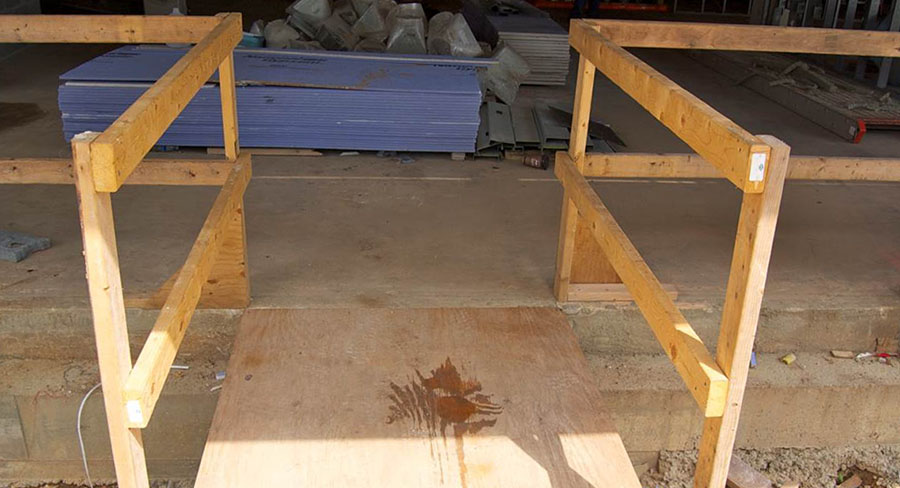An anchor is the portion of a fall protection system that you actually use to attach to the structure or whatever it is you will use to support your weight in case you fall. Typically, we used the flat-style anchors you can nail down to the top of the roof. It has a nail plate; there are a certain number of holes you have to fill all of them up for, depending on what type of system you're using. We've also seen anchor systems that bridge several trusses and things like that; they can be positioned around and moved a lot easier.
Permanent anchors: ensuring long-term safety on roofs
Another type of anchor I wanted to talk about was the permanent anchors; you can find these anchors for about $20 to $25. And the idea is they go underneath the ridge cap on a roof, so as your roofers are going up, they put this anchor in place and then cover it over with the roof cap. So that anchor stays there for the life of the roof so that if anybody, including the homeowner, has to get up on the roof, they already have something set in place to tie off to.
Mobile tie-off anchors: flexible fall protection for large-scale projects
The anchors we use the most depend on the job we're at. So, I just finished an indoor gas station with 70 pump heads and 16 car washes that were only two stories tall. So there we used a mobile set of tie-off anchors which rolled around and had a weighted system in there, and so it worked off friction, and we can take it to the edge, and then people would be tied off that way.
The most popular type of anchor is either a mechanical one like a wedge anchor where you drill a hole, and then there's a mechanical way to tighten up that has engineering behind it. My favorite is cast-in anchors. Not only do you have the anchor and the pull-out of the bolt threads you're using, but you also have all the concrete that is there.
Common anchorage points in residential construction: best practices and pitfalls to avoid
Common anchorage points in residential construction: often, we will see people tying off to the peak as far as putting an anchor nailed to the sheeting on the roof's peak. We’ve also seen the straps nailed to the floor, typically used with the self-retracting lifeline styles. There are ones that span across several trusses for anchors; one common one we will see that isn't approved is that people will wrap their rope around the peak of the truss around the rafters. And I get that it may handle that weight, but it's not rated for that, and you don't honestly know if it will.
Ensuring proper installation and structural evaluation of fall protection anchors
So actually, there is a leave-in anchor as well that can be used for the attic that you nail to the side of the peak of the trusses, and this provides an anchor point for if you’re going to be working in any attic or, say, above a stairwell. Anytime we tie off, there must be a positive anchorage point. The most common for us is either a screw-down or a nail-down plate with a steel loop. If we get the engineer’s approval, there are situations where we can tie off to a piece of steel or even a truss if needed, but that does need to be approved by the engineer to carry the load.
Well, you always want to make sure that you’re fastening through the decking into the members below, the framing members, so the nails are going to
You'll feel as if you're fastening if you're going through plywood only; that’s called a shiner, and it's not doing anything. But if you hit resistance while driving a nail in or we use screws, then you know your roof mount is attached correctly. I call it a roof mount, but it would be a floor mount in this context. Still, it's elevated, it's like a gun turret, and it just rotates 360 degrees so that the retractable yo-yo or whatever you want to call it is facing you, and every time you walk, it’s paying out your fall protection, and as you walk back it'll suck it back in.
Hedge your bet toward safety: There's always a way to be safe. You can tie off above yourself and roll a joist when you've got a couple of joists rolled or a beam rolled. Then you have something you can mount where those roof mounts, and then you can work a certain radius, and then again you do another one. So that as you keep going, you put another retractable, or you put something so that the person can keep working and not exceed the vertical drop because, at that point, you're wasting your time.
You might look good to a compliance officer driving by, but that defeats the purpose because, in the end, you are only cheating yourself or your crew members by allowing them not to be safe.
Fall protection anchors for different environments
Many of us work inside or in other environments or don't have a walking surface such as a roof or a substrate. Take an ironworker or something similar to that where we have an exposed I-beam.
Another standard tool is a beam clamp or a beamer clamp designed to attach around multiple flanges merely by squeezing that trigger and getting it around one side of the I-beam flange, bringing it up like that. Then you will just slide it in, connect, and then we would hang our retractable or put our lanyard to that, and then it would be suspended from the I-beam.
Another very common, mainly when discussing exposed I-beams, angle iron, or even exposed concrete columns, partially or fully poured, is an anchor strap. This is extremely useful, and they come in various lengths. The standard usually in the market is 3, 4, 6, 8, 10, 12, and 20 feet, but many manufacturers can even make them at custom lengths depending on what we need to wrap this around.
Importance of structural evaluation and compliance
For any anchorage attachment, beam strap, or other device, it is still imperative that when we're onsite, other than following the manufacturer's instructions, we still have to verify that the structure that we have fixed this to isn't just something random, that it is still evaluated either by a competent person or by a qualified person.
Laying one truss doesn't make it structurally sound, and at some points, you will have to have somebody actually do engineering or prove that it is capable of withstanding the forces. If the trusses (you only have two) fall to the left side, will it pull everything over and collapse like a house of cards?
If I'm attached with an anchor such as this, and it’s only attached to 26 gauge, and the manufacturer requires 12-gauge (depending on what it might be), then we know that it's not attached to something that will withstand the forces that it's designed to apply to the structure.
So always be sure that we select the right tool for the job that we install and ensure our workers install it in the appropriate place.
